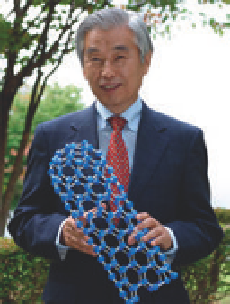Information Technology Reference
In-Depth Information
make very small, fast transistors. At IBM's Thomas J. Watson Research Center,
researchers have constructed an array of carbon nanotubes on the surface of a
silicon wafer and used this silicon to build chips with more than ten thousand
working transistors (
Fig. 15.11
).
In 2004, in Manchester, England, Andre Geim and Konstantin Novoselov
(
B.15.7
) showed how to use graphite to produce a new form of carbon called
graphene
, which consists of an individual sheet of carbon atoms. A single
sheet of graphene is just one atom thick and has some remarkable proper-
ties. It is the strongest two-dimensional material ever found, able to with-
stand stress two hundred times greater than steel without tearing apart. In
addition, graphene conducts heat better than any metal, and electrons in the
two-dimensional layer can move at speeds much faster than in silicon. Geim
and Novoselov were awarded the 2010 Nobel Prize in physics “for ground-
breaking experiments regarding the two-dimensional material graphene.”
12
Researchers all around the world are looking at all sorts of applications of
this new form of carbon - from lightweight, flexible display screens to new
types of electronic circuits. In 2010, researchers at IBM used graphene to cre-
ate transistors that can amplify signals about ten times faster than any silicon
transistor.
Our last example of nanotechnology introduces a new type of electronic
component. As long ago as 1971, Professor Leon Chua from the University of
California, Berkeley, wrote a paper titled “Memristor - The Missing Circuit
Element.” In his paper, Chua argued that in addition to the familiar resistor,
capacitor, and inductor there was a “missing” two-terminal circuit element.
The name
memristor
is derived from
memory resistor
, because the component can
change its resistance according to the current flowing but can also “remem-
ber” its final state when the voltage is switched off. A memristor is analogous
to an unusual sort of pipe whose diameter can expand or shrink according to
the amount of water flowing through it. In a memristor, if electrical charges
flow in one direction, the resistance of the component will increase, and if
charges flow in the opposite direction, the resistance will decrease. If the flow
of charges stops, the component remembers the last resistance that it had, and
when the flow starts again, the resistance of the circuit will be the same as it
was when last active.
Stan Williams (
B.15.8
) and his colleagues at Hewlett Packard (HP) Labs
in Palo Alto, California, have pioneered fabrication of nanoscale memris-
tors (
Fig. 15.12
). The devices have advantages over conventional silicon-based
memory in terms of access speed, power, and density, and can be fabricated
using conventional silicon lithography techniques. HP's process to create an
array of memristors consists of laying down a set of parallel “nanowires” - less
than about ten nanometers wide - coated with a layer of titanium dioxide a
few nanometers thick. A second set of wires is then laid down at right angles
to the first set, and the crossover points of these wires are the memristors.
Commercial versions of memristor memory chips will likely appear in the next
few years, but it will be some time before such technologies present a signifi-
cant challenge to
flash memory
, the durable, rewriteable memory chips used in
digital cameras, smart phones, and other portable devices.
Fig. 15.10. The sixty atom carbon struc-
ture discovered by Robert Curl, Harry
Kroto, and Richard Smalley. They called
this new allotrope of carbon “buck-
minsterfullerene” in reference to the
geodesic domes of American archi-
tect and inventor Buckminster Fuller.
Inevitably this name is usually shortened
to “buckyball.”
B.15.6. Sumio Iijima, discoverer of
carbon nanotubes, pictured with a
model of a nanotube.
B.15.7. Russian physicists, Andre
Geim and Konstantin Novoselov,
working at the University of
Manchester, England, received the
2010 Nobel Prize in Physics for their
discovery of graphene.




Search WWH ::

Custom Search